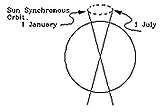|
[an error occurred while processing this directive]
#29. Polar Orbiting Satellites
|
(Files in red–history) |
The space shuttle avoids polar orbits, because flying through the aurora exposes astronauts to radiation and creates other problems. But for studying the aurora, Birkeland currents, polar rain and other phenomena related to the distant magnetosphere, such orbits are very useful. For instance, although the DMSP spacecraft (above) were designed for military needs, scientists have also equipped them with magnetometers, particle detectors and other instruments, which have provided a great amount of scientific information. Different types of satellite orbits have different uses: while the synchronous orbit is best for communication satellites, Lagrangian point orbits help monitor the solar wind before it reaches Earth. A low altitude polar orbit is widely used for monitoring the Earth because each day, as the Earth rotates below it, the entire surface is covered. Typically, a satellite in such an orbit moves in a near-circle about 1000 km (600 miles) above ground (some go lower but don't last as long, because of air friction) and each orbit takes about 100 minutes. |
Next Stop: #30. Magnetic Storms
- Back to the Index Page
Timeline Expanded timeline Glossary
Author and Curator: Dr. David P. Stern
Mail to Dr.Stern: education("at" symbol)phy6.org
Co-author: Dr. Mauricio Peredo
Spanish translation by J. Méndez
Re-formatted 3-13-2006

